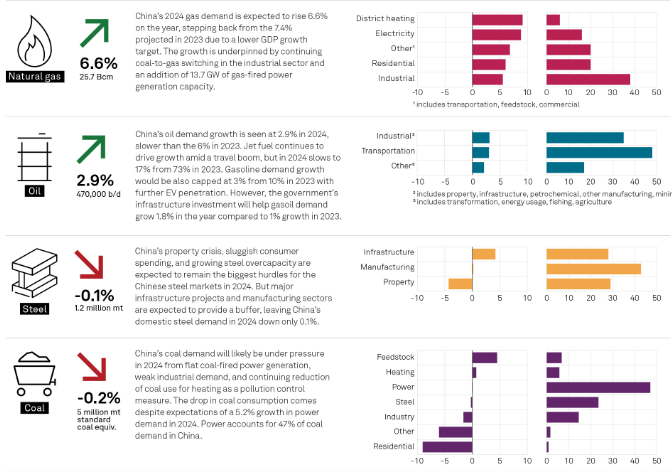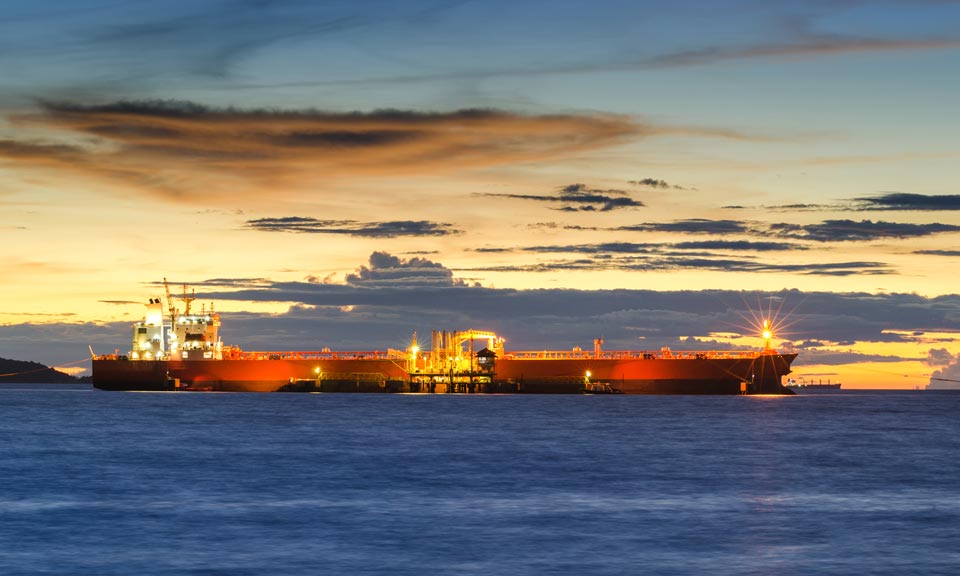Infographic: What China’s lower GDP growth means for 2024 commodity demand

China on Jan. 17 released its 2023 GDP growth at 5.2%, meeting its target set in March last year. S&P Global projects China’s 2024 GDP growth to slow to 4.7% after the country's annual economic conference held in December implied that any fiscal and monetary measures taken in 2024 were unlikely to be more aggressive than in 2023. This sets a weak tone for commodity markets in terms of end-user demand.
Click here to see the full size version


News
While Middle Eastern countries and or national oil company (NOC) participation in decarbonization strategies appear to lag other regions , Rajeev Lala, Director, Upstream Strategies and Transition at S&P Global Commodity Insights, said it is essential to dig a bit deeper to understand the regional approach to decarbonization. “The region produces 30% of the world’s oil, and its economies are primarily hydrocarbon-based, so many leaders understand that the opportunity to optimize their hydrocarbon resources is most significant in the short term, and over the long term, that value becomes less certain,” Lala said. “While oil will be needed for decades, their window of opportunity to gain export revenue from those resources is shrinking. The national economic priorities and the shrinking window to gain export revenue make the NOCs and their host governments even more dependent on hydrocarbon developments in the near term.” Lala said he was intrigued by how COP 28 got many NOCs to join the decarbonization initiative and thinks that, in the near term, the group wanted to push back on investor sentiment that has largely soured on oil and gas. He said there is a palpable sense that ‘the window is shrinking’ for the Gulf countries. “So, they ask themselves: How can we profit? How can we invest in tomorrow’s technologies today? And the largest NOCs –Saudi Aramco, ADNOC, and KPC– are asking themselves if they are willing to explore new business areas and go big if the opportunity presents itself (ADNOC was reportedly looking at buying BP),” Lala said. Lala said there is also a growing understanding in the aftermath of the European GIOC sentiment swing (first with gusto towards low carbon and then a reality check in 2022-2023) that low-carbon businesses have significant hurdles in achieving returns. “The challenges for the regional NOCs are even starker when you consider that their internal rates of return are probably the highest in the global oil landscape, so prioritizing low-carbon businesses with relatively lower returns is difficult for management,” Lala said. “Nevertheless, if decarbonization leads to higher exports (such as Aramco developing gas to substitute for oil being burned by power plants during summer), then decarbonization becomes a priority. Suppose lower carbon activity supports protecting the core (hydrocarbon business) and extending the value generated from the oil and gas sector. In that case, you can expect regional players are certainly working toward that goal.” Oman is a good example, Lala said, of working with oil and gas companies to build green hydrogen capacities. Regarding decarbonization strategies, Lala segments Middle Eastern countries and companies into two primary groups—the drivers and the participants. The drivers are active and vocal in driving (and reacting to) global narratives on oil demand and the carbon-emission story. Saudi Aramco and ADNOC fall under this category. They are keen to be the ‘last producer standing’ and are banking on the premise that the world will need oil, and they intend to be the provider of the lowest-cost and lowest-emission barrels. The participants are a group that views the world’s appetite for oil as shrinking, so they see the need to participate and make the most of their market opportunities in the short term. These countries/NOCs believe that there are limits to their ability to influence the global energy landscape, either because they lack the scale or have significant domestic issues. Both groups primarily target maximizing revenues in the short term, speeding the development of existing discoveries, and taking opportunistic exposure to low carbon as a business opportunity if they can afford it. Historically, this topic of ‘low carbon as a business’ has sat outside the purview of the core NOC. However, Lala said the region’s NOCs remain tethered to the oil value chain, with decarbonization of core operations as the primary driver of low-carbon activity. Lifting the veil on low-carbon projects From the outside, Lala said some might perceive the NOCs as not doing enough relative to low-carbon investments. Still, a closer look reveals that some of the region’s NOCs are participating in renewables and low-carbon projects but are doing so indirectly. For example, ACWA Power in Saudi Arabia is a private power company with significant existing renewable capacities and more under development. Saudi Aramco has primarily focused on upstream and downstream developments. The renewables story is driven by other government and private players, with companies like ACWA doing the heavy lifting. Interestingly, the Saudi Public Investment Fund (the country’s sovereign wealth fund) expanded its stake in ACWA to 50% in 2020. The story in Abu Dhabi is similar, with Mubadala taking the lead on ‘low carbon as a business’ activity, even though both Mubadala and ADNOC have the same leader – Sultan al Jaber. So, most of the host country’s low-carbon activity was not directly run by the NOC, which historically would usually take the lead on fulfilling national economic priorities. The Gulf governments and national oil companies — notably those of Qatar, Saudi Arabia, and the UAE — are implementing carbon capture, utilization, and storage (CCUS) and other emissions mitigation strategies seeking to keep the emissions intensity of their production low as they maintain or expand capacity, Lala said. At the other end of the spectrum, he said, international oil companies have a significant opportunity to help some of the region’s highest methane emitters — Algeria, Iraq, and Libya — via gas capture and other projects that offer more immediate economic upside alongside emissions reduction. The ‘last producer standing’ group led by Saudi Arabia and the UAE is growing in global influence, with an increasingly unified voice (e.g., at COP28). “The move may give OPEC a new raison d’être and reinvigorate the push to decarbonize hydrocarbons and extend oil and gas life spans,” Lala said. “In this vein, Saudi Arabia and the UAE are championing a new Oil and Gas Decarbonization Charter (launched at COP28), under which companies have pledged to bring methane emissions close to zero by 2030. “I believe that the clean-barrel premium is coming, although it is difficult to pinpoint the timing or what it will look like,” Lala said. “I suspect Aramco and ADNOC aim to drive the global narrative towards this direction.”

News
A report published by S&P Global Sustainable1 following COP28 in December 2023 analyzed the greenhouse gas (GHG) emissions and climate disclosure rates of companies headquartered in the Middle East and found that, based on the S&P Global Trucost Environmental dataset, companies in the region have increased their GHG disclosure rates during the past five years. Still, more work is needed since the region's emissions have continued to climb. Out of a universe of 632 companies headquartered in the Middle East for 2021 (the most recent year data is available), around 25% disclose Scope 1 and Scope 2 GHG emissions, a rate that is approximately 20% lower than disclosure levels for the rest of the world. However, the S&P Global Sustainable 1 analysis showed that companies headquartered in Turkey and the UAE have higher disclosure rates on Scope 1 and Scope 2 emissions than the averages for the rest of the world. The average Scope 1 disclosure rate for the UAE is 53% and 56% for Scope 2, compared to averages of 46% and 45%, respectively, for the rest of the world. Among the universe of UAE-headquartered companies in the analysis, S&P Sustainable1 found that disclosure levels are 20% higher than in the rest of the Middle East. Alongside improvements in disclosure, emissions are still rising While disclosure rates are improving in the Middle East, the region has significant work to do to lower emissions. GHG emissions totaled 1.1 billion metric tons for the 632 Middle East-headquartered companies in our analysis* for 2021, the most recent year available. Five years earlier, that number was 370 million tons — a difference partly explained by the smaller analysis universe of 310 companies in 2017. It also demonstrates that companies may have to accelerate their transition pathways to reduce their emissions as their countries transform to become less dependent on fossil fuels. Like many parts of the world, the region is also experiencing increasing climate stress, as the physical impacts of climate change manifest in rising temperatures, droughts, and floods. As they transition their economies to depend less on fossil fuels, many Middle Eastern countries will take steps to address higher energy demand from their growing populations to cope with an ever-hotter desert climate that needs more power generation, especially in energy-intensive industries such as water desalination. *(The numbers in this analysis only represent the emissions of companies in the S&P Global Sustainable1 Trucost Environmental dataset and do not represent total emissions for all companies located in the Middle East.). This report was originally published as part of a joint publication by S&P Global Sustainable1 and the Dubai Financial Market, a stock exchange in Dubai, United Arab Emirates, where the UN’s COP28 climate change occurred. You can read the full report, including a Foreword from Dubai Financial Market CEO Hamed Ali, here .

News
India’s role in global oil markets is set to expand at a fast pace by the end of the decade, making it the biggest hub for demand growth. Battling high prices, oil diplomacy with countries such as the US and Russia, as well as revival of flagging upstream production will be some of the key priorities for the new government. Related feature: INDIA ELECTIONS: Refining capacity, crude output, storage to top new government's oil agenda Click here for full-size infographic

News
(Latest update: May 10, 2024) Related content: Russian crude exports by non-G7 tankers hit new high in April since price cap Russia, one of the world’s largest oil suppliers, has increasingly turned to non-Western firms to transport its crude to overseas buyers during its ongoing war with Ukraine . With a dual goal of undermining Russia’s war chest without creating significant disruptions to global supplies amid inflation pressure, G7 countries and their allies have banned tanker operators, insurers and other services firms from facilitating seaborne Russian crude exports unless the barrels are sold for no more than $60/b. The price cap regime, which came into force Dec. 5, 2022, does not directly cover tankers flagged, owned and operated by companies outside the G7, the EU, Australia, Switzerland and Norway, and not insured by Western protection and indemnity clubs. While such ships tend to be older and less maintained, their share in Russia’s crude exports market has been rising in recent months amid strengthening prices of Urals -- the OPEC+ member’s flagship crude grade -- and tightening sanctions enforcement by the West. Non-price-capped tankers have a larger market share in shipping Russia’s Pacific crude exports, according to analysis of S&P Global Commodities at Sea and Maritime Intelligence Risk Suite data. Crudes such as Sokol, Sakhalin Blend, and Eastern Siberia–Pacific Ocean grades are more often involved in these trades than Russian barrels from Baltic or Black Sea ports like Urals. Tanker operators in Greece, Europe’s top shipowning nation, managed to keep their traditionally strong market position in Russia in the first few months since the price cap took effect before giving ways to their peers in the UAE, Russia, China and Hong Kong. Related content: Interactive: Global oil flow tracker